The EASY Way to Sprout Lentils
And a revitalizing springtime salad to make with them
Years ago, for my book Bowl, I created a “sprouted lentil bowl” that included instructions on how to sprout the lentils at home. My steps involved a whole kit of household tools: a wide-mouth glass jar, fine mesh or cheesecloth, rubber bands or kitchen twine, chopsticks, a rimmed baking pan.
I remember laboring over that recipe so that all the little steps would be clear (“This sounds very fussy, but…” is not my favorite aside to include in a recipe, but I felt it was necessary there), and looking back at it, I think I did okay. I just didn’t want people thinking they needed to go buy a sprouting kit.
But once I finalized that recipe, published Bowl, and moved onto other projects, I pretty much stopped sprouting at home. The idea of it always felt fussy.
Just this year, however, as I’ve continued to pore over Sapna Punjabi’s really terrific book Dal Chawal, I encountered an easy-breezy method that’s brilliantly and clearly straightforward. There’s just a bowl, some cheesecloth, and a sieve. I had to do it immediately.
Sprouting Beans: Why bother?
Sprouted nuts, seeds, grains, and beans have major food co-op energy, and I love them for that. But aside from enjoying the more varied texture, which make lentils in particular light and salady, as well as the fascinating science-experiment element of the process, it wasn’t until recently that I learned why sprouting is even worth the trouble.
The top reason is that sprouted beans (and seeds and nuts) are easier on the stomach. Sprouting releases a digestive enzyme and makes all the nutrients (including the protein) more available to be absorbed.
Additional reasons: Similar to the logic of soaking beans and rice for a few hours or overnight before you cook them, sprouting reduces the presence of “anti-nutrients” like phytic acid, which can hinder the absorption of certain nutrients and affect digestibility. (That said, phytic acid is also an antioxidant, and it appears in small amounts, so it’s not all bad.) And sprouting can reduce the glycemic index of certain foods, too, including beans. Here’s an article I’ve found helpful, which has more information for understanding why sprouting is worthwhile.
Additionally, Sapna writes of how sprouted beans are full of prana, or life-force energy in Ayruvedic terms — which makes perfect sense if you think about it. The beans are literally in the process of sprouting life!
Are you a sprouter? Why do you like doing it?
How to Sprout Lentils
Here I’ve sprouted standard brown lentils. Any whole pulse (not a split one — learn from my mistake last week) can likely be used, and beyond that, lots of things can be sprouted besides beans — grains, nuts, seeds, buckwheat — though the timing will be different for each one.
This method is based on Sapna’s brilliantly straightforward instructions in her recipe for Sprouted Moong Bean Salad in Dal Chawal.
One Night Before You Go to Bed: Put your lentils (I find that ½ cup is plenty; you’ll get about 1 quart of sprouted lentils) in a medium bowl and cover them with water. Soak overnight or for about 8 hours.
The next morning: Drain the lentils through a fine-mesh sieve, and tap it several times to shake off the excess water. Cut a large piece of cheesecloth and pile the soaked lentils in the middle. Gather up the ends, twist them up, and put the twisted up parcel in the sieve. Set the sieve over the bowl you used for soaking to catch any drips.
Twice that day: Grab the parcel of lentils by the twisted-up ends, and rinse the lentils (through the cheesecloth) well under running water. This is to keep them moist and prevent anything unwanted from burrowing in. Return the parcel to the sieve, again set over the bowl.
The next day: Repeat this rinsing step in the morning. Rinse once or twice more that day if needed, until little “tails” that are ¼- to ½-inch long start to appear. Now, you have sprouts. You can put them in an airtight container and keep them in the refrigerator for 2 to 3 days. Rinse them well in a sieve before you eat them.
Sprouted lentils work great in a salad, with their lighter, more feathery texture, or you can stir them into a medley of warm roasted or stir-fried vegetables, or treat them as something of a garnish for various bowl-type dishes. You don’t have to blanch them first, but I do like their texture that way.
In today’s recipe, I build plenty of juicy, creamy, crunchy textures in the bowl with the sprouts, toss everything with a simple vinaigrette, and then I can easily eat the whole bowl as a meal.
Sprouted Lentil Salad with Cucumbers & Dijon-Cumin Vinaigrette
I’ve purposely made this salad flexible, so that you can add whatever you’ve got on hand and customize it to your tastes.
It also works with unsprouted lentils — just simmer them until tender, then drain and cool them before combining with the rest of the ingredients.
Change it up: Throw in 1 or 2 boiled eggs or another favorite protein. Serve it over your favorite salad greens to fill out a plate. Spoon it into little lettuce cups or over toasts or pitas.
Yield 2 to 4 servings | Prep & cook time 20 minutes
1 quart (4 cups) sprouted lentils (from ½ cup dried), rinsed and drained
Fine sea salt
1 medium cucumber or 2 Persian cucumbers, sliced thinly
A sweet component: 1 apple or pear, cubed; sliced strawberries; halved cherry tomatoes; a handful of dried currants, cherries, or other dried fruit
An allium component: ¼ cup pickled onions or shallots, 1 or 2 thinly sliced scallions; a handful of thinly sliced raw red onion, diced sweet onion, or diced shallot (soaked in cold water for 10 minutes to soften the flavor, if you like)
A juicy-crunchy component: 2 to 4 thinly sliced radishes, a grated carrot, a handful of snow peas or stemmed snap peas, 1 or 2 sliced celery stalks
A creamy component: Crumbled goat cheese, feta, or ricotta salata; cubed avocado
A crunchy garnish: ¼-½ cup toasted almonds, pumpkin seeds, walnuts, etc. Frizzled shallots or fried garlic would be good, too.
Dijon-Cumin Vinaigrette
4 tablespoons olive oil
Juice of 1 medium lemon
1 tablespoon apple cider vinegar
2 teaspoons Dijon mustard
½ teaspoon toasted cumin seeds, crushed
½ teaspoon honey
¼ teaspoon fine sea salt
1. Bring a large saucepan or pot of salted water to boil. Add the lentils and blanch them for 1 minute. Drain them through a colander or fine-mesh sieve, then spread them out on a plate or sheet pan to cool to room temperature.
2. Meanwhile, toss the cucumbers and ½ teaspoon salt together in the colander or sieve, and let stand for about 10 minutes. Give them a gentle squeeze to extract some water. Taste one — if it’s too salty, rinse the cucumbers and squeeze them dry again.
3. To make the vinaigrette, combine all the ingredients in a jar or bowl and shake or whisk until emulsified.
4. Combine the lentils, cucumbers, and your additional components of choice (except the garnish!) in a serving bowl, and toss with the dressing. The tossed salad will keep pretty well for a day or two. Just before serving, add the crunchy garnish.


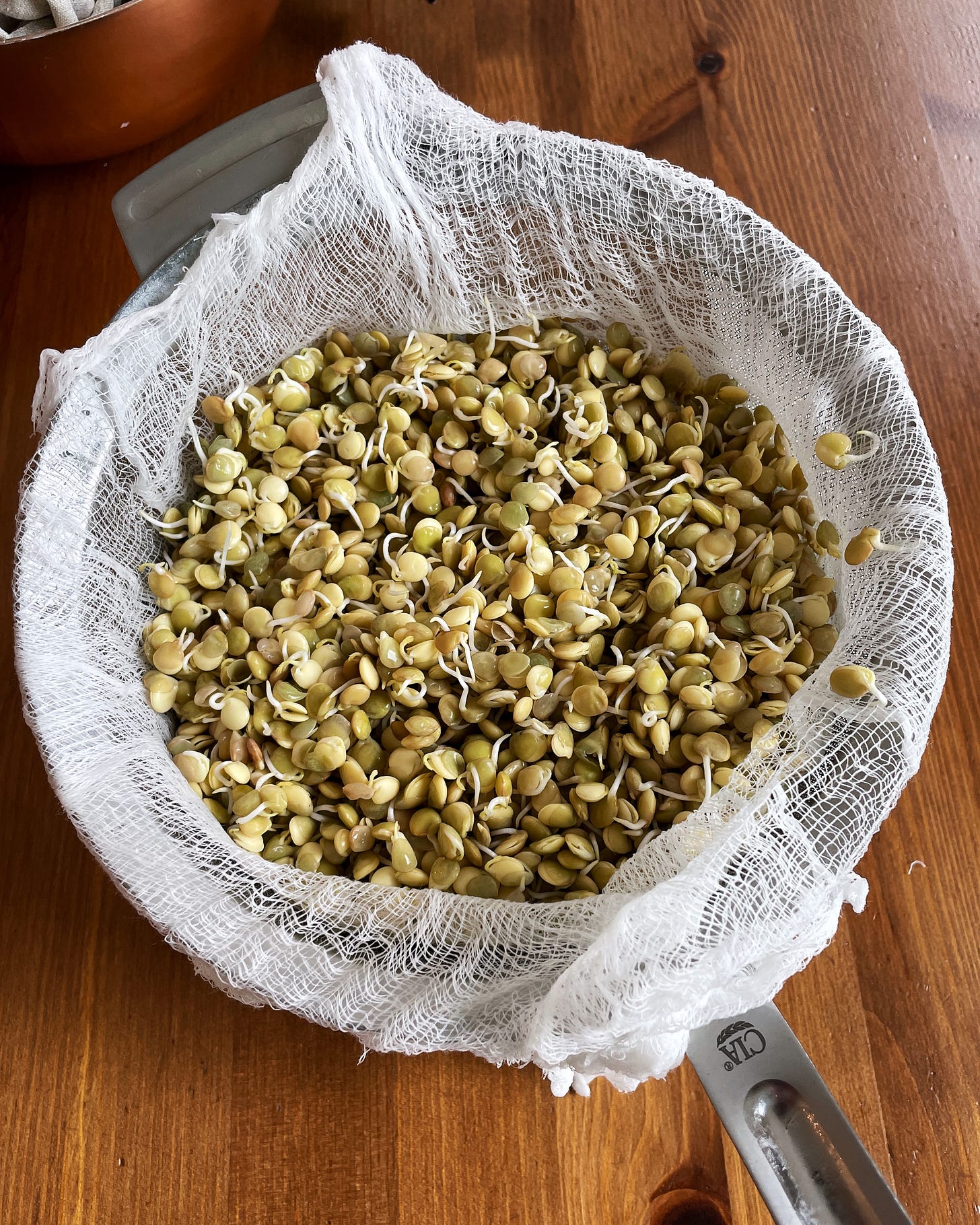
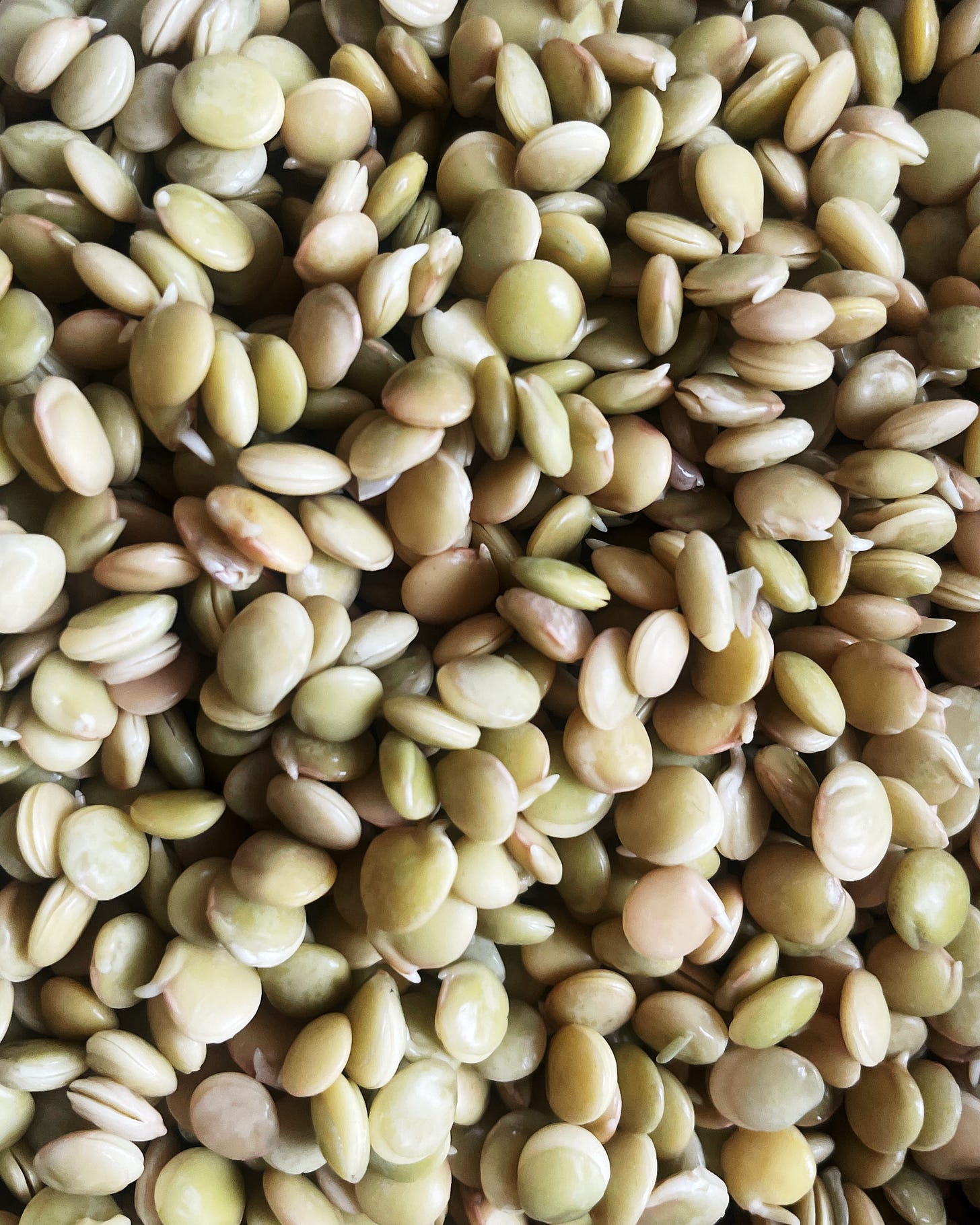
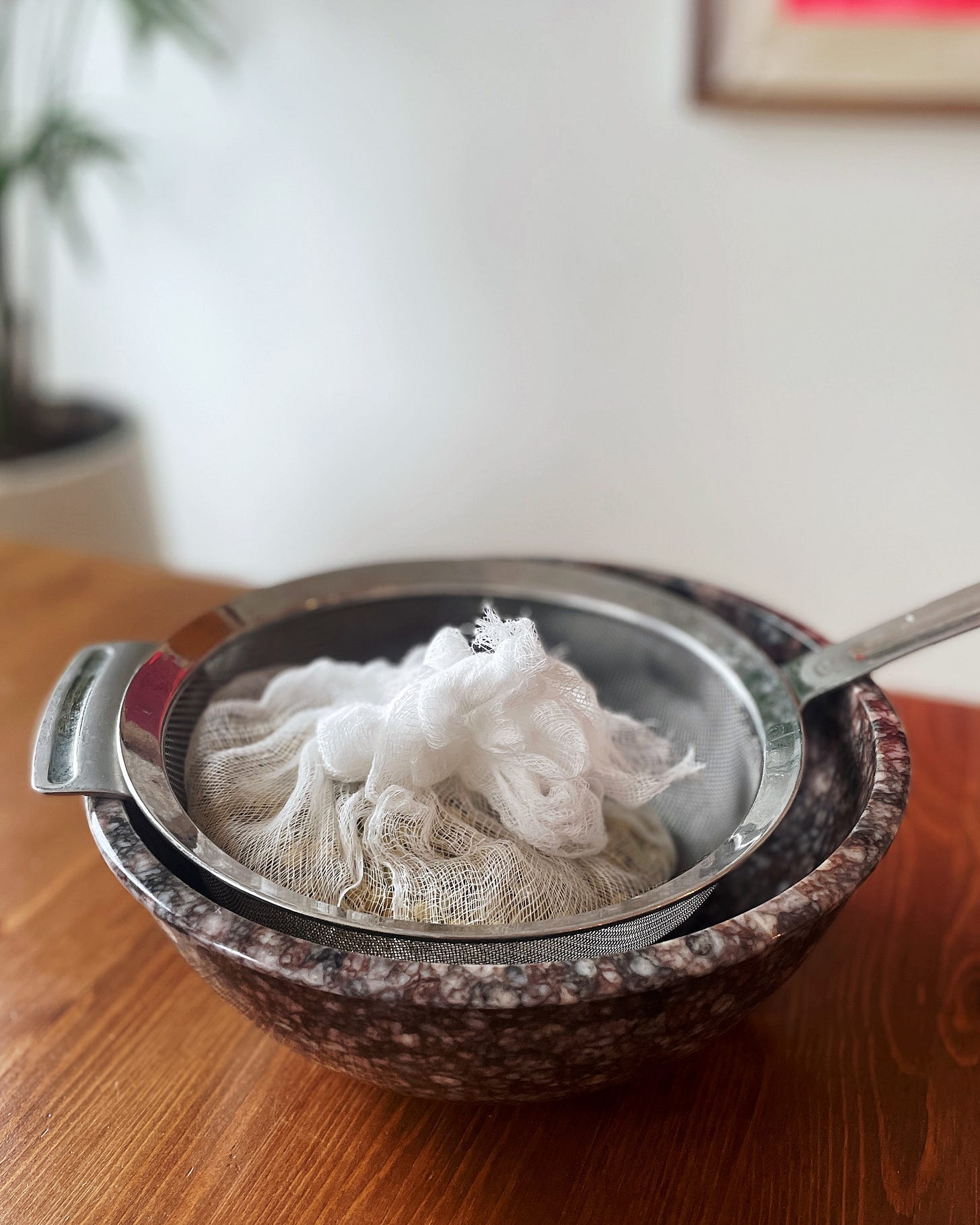
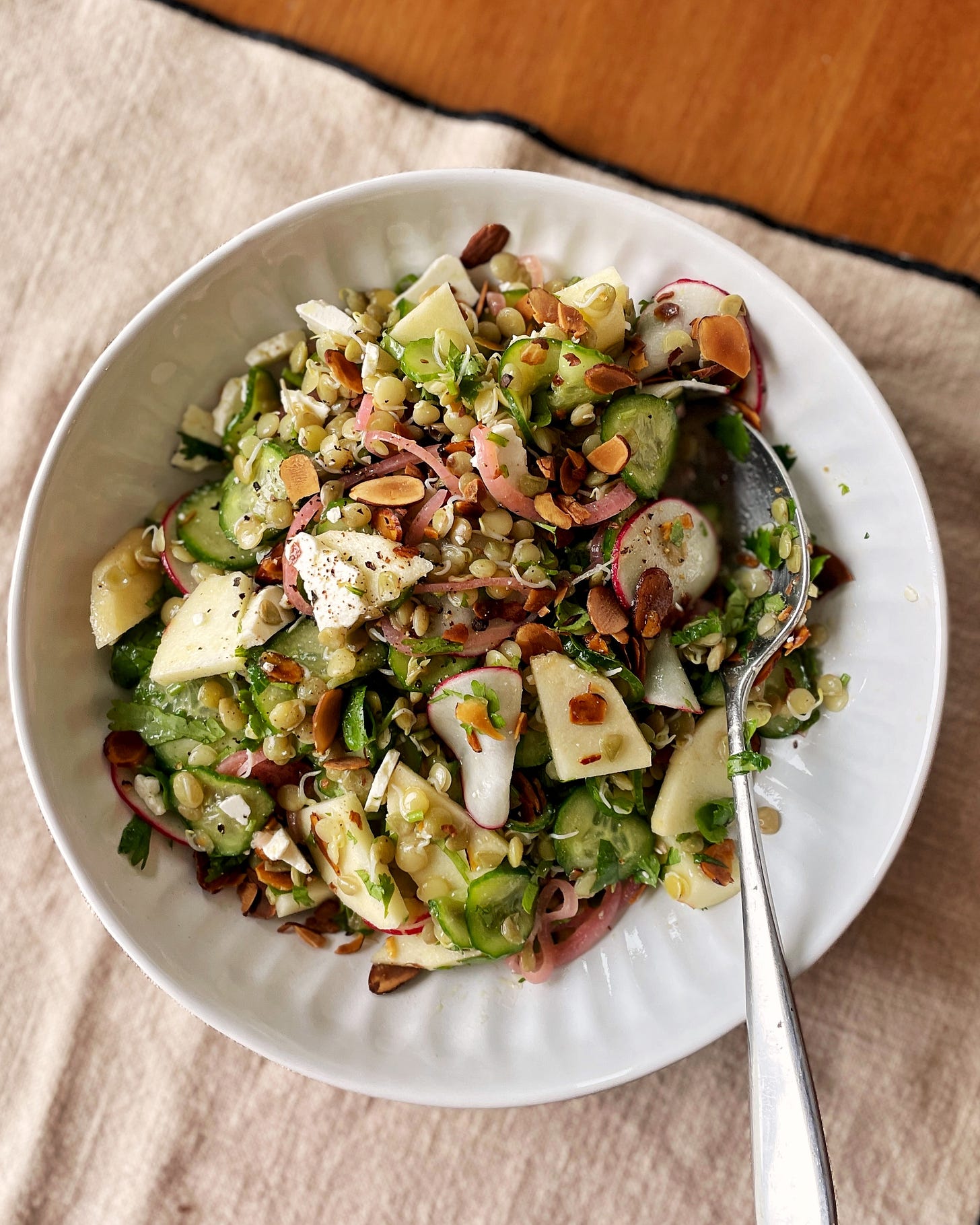
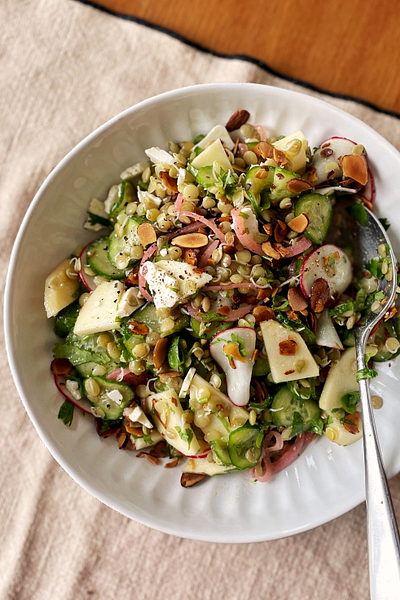
These sprouts are so good and so easy! I have used more traditional sprouting methods and agree that it's just too much to keep up with. Thanks for sharing this sprouting method. Also, this was my first experience with sprouted lentils, so more thanks for that! The salad was also quite tasty, and I appreciate that the recipe is a template that includes several options for each component. I'll start sprouting some black lentils tonight to see how they compare.
So so good. Thank you for the recipe!